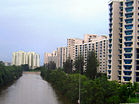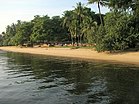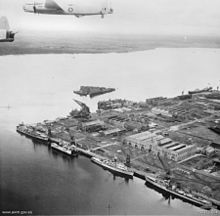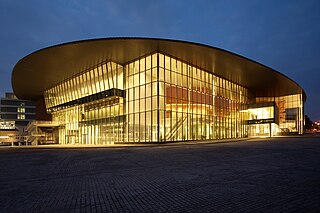
Woodlands is a planning area and residential town located in the North of Singapore. As of 2019, the town has a population of 254,733. Located approximately 25 km (16 mi) north of the central business district (CBD), it is the densest planning area and is the regional centre for the northern parts of the country.
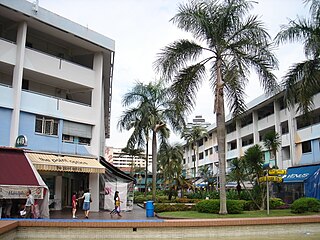
Clementi is a planning area and residential town located at the easternmost fringe of the West Region of Singapore. The town borders Bukit Batok to the north, Bukit Timah to the northeast, Queenstown to the east and Jurong East to the west.
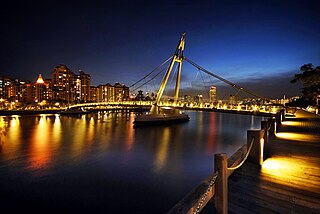
Kallang is a planning area and residential zone located in the Central Region of Singapore.

Yishun, formerly known as Nee Soon, is a residential town located in the northeastern corner of the North Region of Singapore, bordering Simpang and Sembawang to the north, Mandai to the west, the Central Water Catchment to its southwest, Ang Mo Kio to its south, as well as Seletar and Sengkang to its east and southeast respectively.

MacPherson is a neighbourhood located within the district of Geylang in the Central Region of Singapore. Its location roughly corresponds to the identically titled subzone in the Geylang Planning Area and is approximately sandwiched between the neighbourhoods of Aljunied and Paya Lebar. MacPherson largely consists of various public housing estates centered on Circuit Road and an industrial area. The Pelton Canal runs through the neighbourhood, which separates a private housing estate off MacPherson Road, and the public housing estate along Circuit Road.

Bukit Panjang is a planning area and residential town located in the West Region of Singapore. A portion of this town is situated on a low-lying elongated hill. The planning area is bounded by Bukit Batok to the west, Choa Chu Kang to the northwest, Sungei Kadut to the north, the Central Water Catchment to the east and Bukit Timah to the south. Bukit Panjang New Town is located at the northern portion of the planning area. Bukit Panjang has an average elevation of 36m/118 ft.

Bedok is a planning area and residential town located in the geographical region of Tanah Merah along the south-eastern coast of the East Region of Singapore. Bedok is bounded by five other planning areas: Paya Lebar to the north, Hougang to the northwest, Tampines to the northeast and east, Geylang to the west and Marine Parade to the southwest. It also shares a maritime boundary with the Singapore Strait to the south and southeast.

Yew Tee is a residential area in the West Region of Singapore. Yew Tee is a cluster of Housing and Development Board flats and private condominiums, As a relatively new estate, a large proportion of its residents are young families and middle income earners.
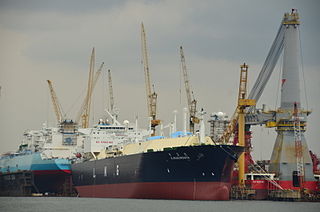
The North Region of Singapore is one of the five regions in the city-state. The region is the second largest region in terms of land area, and has a population of 582,330. Woodlands is the regional centre and also the most populous town with 255,130 residents living in the area. Comprising 13,500 hectares of land area, it includes eight planning areas.
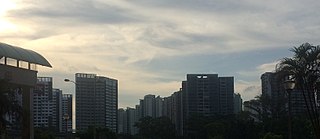
Fernvale is a neighbourhood of Sengkang New Town in Singapore. It is located between Sungei Punggol and the proposed Sengkang West Industrial Estate. The house numbers of the public apartment blocks in Fernvale begin with the number '4' (4xx). Fernvale is the newest neighbourhood in Sengkang Town to be completed by the Housing and Development Board (HDB). Seletar Mall, a new shopping amenity which houses Sengkang's first cineplex, is located within this neighbourhood. In 2017, a proposed community facility to be located next to Seletar Mall was announced, which houses a community club, childcare centre, hawker centre and wet market. The community facility which was slated to be ready by the second half of 2020, had stopped construction in April 2020 due to the COVID-19 measures set by the government. Construction of the facility has since continued in the second half of 2020 and was completed in 2022.
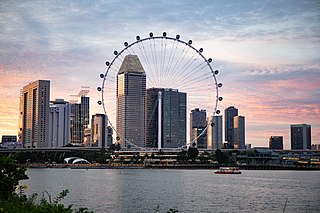
This article shows the notable future developments in Singapore. Most of them are currently under construction with most to be completed within the next five years.

Hillview is located in Upper Bukit Timah, Northwest Singapore. The neighbourhood overlooks Bukit Timah Hill, hence its name.
Yuhua is a subzone region located in the town of Jurong East, Singapore. Yuhua comprises two subzones, Yuhua East and Yuhua West. The area's HDB flats are under the management of Jurong-Clementi Town Council and the people of this precinct are represented in parliament by either Grace Fu or Rahayu Mahzam, depending on where they stay.
Chong Pang is a housing estate located in the subzone of Yishun West along the Sembawang–Yishun boundary in the town of Yishun, Singapore. It was named after the former Chong Pang village. It has precincts of Neighbourhood 1, part of Neighbourhood 7 and private residential areas along Sembawang Road.
Hong Kah is a residential precinct in Jurong West, Singapore. It is bounded by the PIE, Corporation Road, Jurong Canal Drive, Jurong East Avenue 1 and Jurong Town Hall Road. It is named after the former 'Hong Kah Village'.

Canberra MRT station is an elevated Mass Rapid Transit (MRT) station on the North South line, located along Canberra Link at the junction with Canberra Way in Sembawang, Singapore. It is the second infill station on the MRT network, and the first in Singapore with a platform linked directly to an overhead bridge at the same level. With several green features included in the station during construction, it was also the first MRT station to be awarded Platinum for the Building and Construction Authority's Green Mark for Transit Stations, as a result of the construction team's efforts to integrate landscaping and using eco-friendly materials in the construction of the station.

Canberra Plaza is a New Generation Neighbourhood Centre (NGNC) built by the Housing & Development Board (HDB), the government agency in charge of public housing development in Singapore. It is one of the new Neighbourhood Centres (NCs) constructed by HDB in 10 years after the completion of Pioneer Mall and Punggol Plaza in 2004. CNN reported that Canberra Plaza will provide a "complete live-work-play-learn environment for residents and signifies Singapore's public housing for the future".

Bukit Canberra is an integrated sports and community hub next to Sembawang MRT station. The hub houses facilities including an indoor sports hall, the largest ActiveSG gym in Singapore, a six-lane sheltered swimming pool, and an eight-lane lap pool. There will also be 3 km of running trails, of various difficulties, passing throughout the development. It will also house a polyclinic, a senior care centre, and a hawker centre.
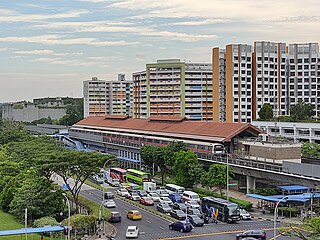
Khatib is a subzone of Yishun, Singapore. It is bounded by Yishun Avenue 1/2/3 to the south, east and north respectively, and Sembawang Road to the west.

